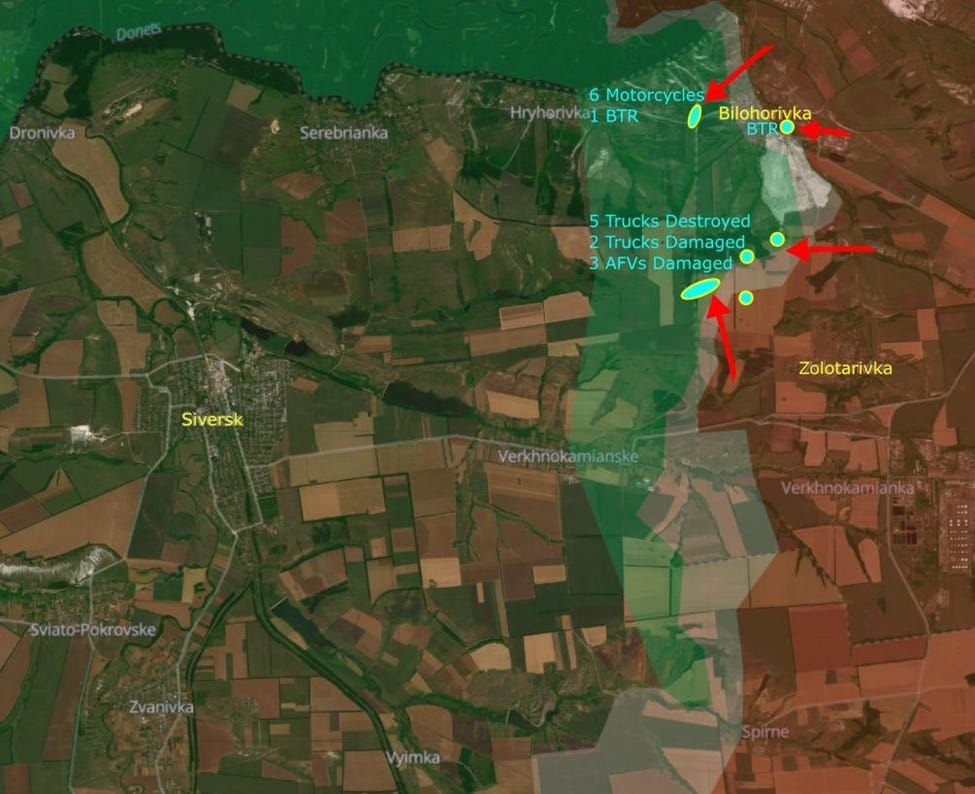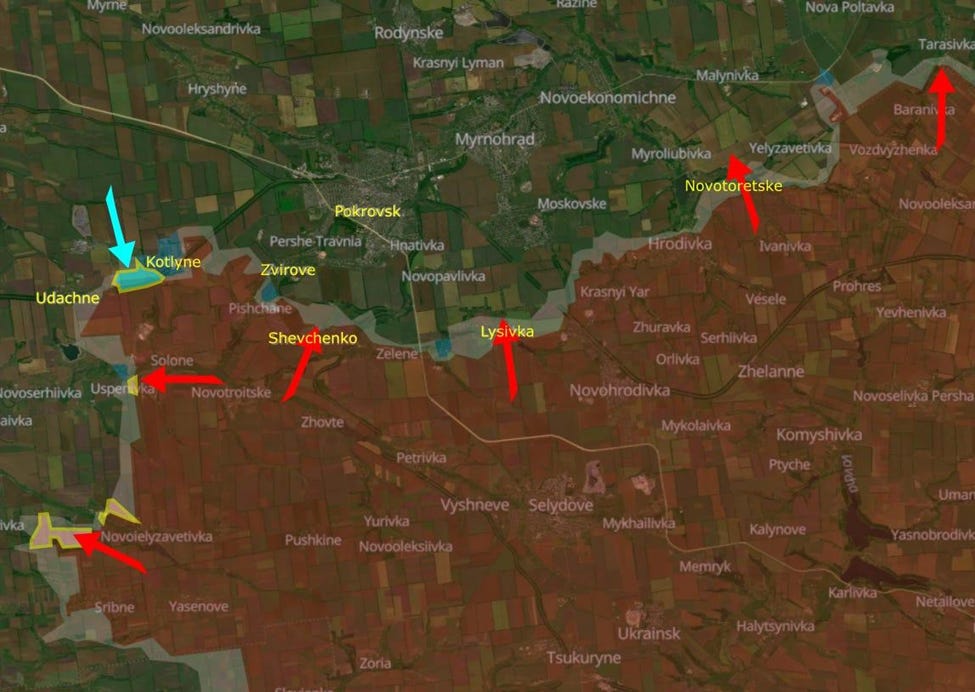(…continued from Part 1…)
***
Siversk
North of Siversk, soldiers from the 12th Azov Brigade destroyed enemy defensive positions while bringing back a fallen soldier. Ukrainian positions in the same forest were shelled.
Another Russian assault tried moving behind Bilohorivka from Zolotarivka but it was eliminated with the loss of at least five trucks and five more vehicles damaged. Six motorcycles and a BTR made it behind Bilohorivka before they were eliminated. No territory changed hands.
The commander of the 10th Mountain Assault Brigade, Roman Darmogray, was one of the brigade commanders chosen to lead a corps back in February. Colonel Vladimir Poteshkin was appointed the new commander.
***
Chasiv Yar
The 5th Assault Brigade damaged or destroyed 11 Russian vehicles that approached the canal. A Ukrainian truck was hit 5 km from the front lines. The Russians bombard the forest just north of the town. The small Russian gain inside Chasiv Yar from over a week ago was confirmed.
***
Toretsk
Earlier the last week, the Russians were very excited by a mechanised infantry attack of theirs. As first, they’ve hit ZSU positions 2500 meters north and northwest of Toretsk with multiple rocket launchers, then took the Ukrainians by surprise and drove all the way to Nelipivka, while heavily supported by attack UAVs. With other words: one of their assault groups was thus something like two kilometres behind the Ukrainian lines. This has forced Ukrainians to adjust - and thus withdraw - some of their positions around northern Toretsk. The fighting along the road from Toretsk to Nelipivka is raging ever since. After nearly a week of this battle, there are no indications that the Russians have managed to exploit this opportunity for an advance further towards north (to Kostiantynivka, for example), or west (to Stepanivka). That said, the situation remains tense and unless the ZSU manages to destroy the Russians that entrenched themselves in southern Nelipivka, and then along the road to it, in the long term, this is likely to enable the Russians to grab yet another sizeable chunk of territory.
The 28th Brigade stopped yet another assault over the canal with DPICM but the Russians did widen the crossing by Druzhba.
Ukrainian positions in Toretsk are shelled. The 12th Azov Brigade sends drones into buildings and engages vehicles in the open and infantry in houses.
***
Pokrovsk
Ukraine attacks Russians in Udachne. They also conducted an assault and drone attack in Kotlyne. Russians bombard Zvirove.
A Russian assault through Novotoretske loses vehicles and personnel as far as 4 km north of the village.
Between Pokrovsk and Toretsk, Russia was able to make advances up to 4 km.
Russia reports there are a couple thousand Ukrainian drone strikes every day in this sector.
Because Pokrovsk is within range of Russia artillery, it is slowly being destroyed.
For March, the 414th Brigade claimed 1704 Russian casualties and was given credit for 1629, which is about 10% of all Russian casualties for the month. In the first 12 days of April they claimed 1073 Russian casualties (685 killed and 388 wounded).
***
Andriivka
Seven minutes of the 72nd Brigade’s drones destroying Russians. There was very little change in territory.
A kilometer east of Novy Komar the Ukrainians used thermobaric rockets.
***
Kherson
Russia reports that Ukrainian drones that are jammed by EW in the Kakhovka and Nova Kakhovka region switch to different frequencies and continue operating.
***
Crimea
Ukrainian naval drones used to regularly penetrate Sevastopol Bay but Russia established a multi-tiered defense system that detects and destroys them.
***
Occupied Territories
With Ukraine sticking to Trumpf-imposed ‘moratorium on strikes against critical infrastructure’, the Ukrainians switched over to more air strikes on the Russian air defences. Three Russian Buk air defense systems were destroyed in 12 hours.
A Buk system in Luhansk was destroyed, too.
Russia plans to restart the Zaporizhzhia Nuclear Power Plant when “military and political conditions allow.” Some of the risks in restarting the plant are the lack of cooling water, lack of trained personnel and a lack of reliable electricity to operate the circulation system that cools the reactors. That said, the crucial issue is that so much of equipment of this NPP has been replaced already before the Russian invasion, that the Russians simply can’t re-connect it to their network without significant work (and thus investment).
Six million people live in the occupied territories and any indication of Ukrainian sympathies can result in arrest and torture or even death. Nearly the entire population has been forced to get a Russian passport because it is impossible to survive without them. There are also stipends to move to Russia or for parents of newborns that have Russian birth certificates. A Russian passport is needed to prove property ownership and allows access to health care and retirement income.
Some hospitals in the occupied territories have a passport desk to process desperate patients. One hospital in Zaporizhzhia was closed because the staff refused Russian citizenship.
Homes have been seized and offered to Russians for low mortgage rates. People without a Russian passport are declared stateless and must register with the Internal Affairs Ministry. The absence of the passport can result in the loss of custody of children, jail or death.
The Moscow-installed governor in the Zaporizhzhia region said, “We understood that these people could not be won over and that they would have to be dealt with even more harshly in the future,” he said. He then alluded to making “some extremely harsh decisions that I will not talk about.”
If you are a male and have a Russian passport, the pressure doesn’t stop because they then coerce you to join the Russian army. Ukraine’s Crimean leadership in exile said on February 25th that of 694 soldiers reported dead fighting for Russia, 525 were likely Ukrainian citizens that took a Russian passport. By the end of 2023, 30,000 Crimean men have been conscripted into the Russian army since 2014.
A mother, father and 19-year-old son were arrested in the summer of 2022. They were never told why they were detained, nor were they charged with any crime. The son was beaten and tortured with electricity until he was released two weeks later. His mother escaped to Ukrainian-controlled ground when she was released in the spring of 2023. The son was able to escape last month with the help of the Ukrainian Navy’s Angels Special Reconnaissance Unit. As of July 2024, the Angels had evacuated 69 people under difficult circumstances that took detailed planning.
SOS Donbas is a Ukrainian helpline for people in the combat zones and occupied territories. They received more than 57,500 calls in 2024 and advised people on how to leave safely and what taking a passport meant. They were told to do whatever they needed to do to stay safe, even if it meant taking the passport. Leaving is the best option for some, but everyone will be screened in a filtration center. If a woman is trying to leave and they find out her husband was a Ukrainian soldier, she would be in danger. For her, it would be better not to leave.
For those that do leave, they cannot sell their home or possessions. They cannot take much money. And they have to enter Russia, successfully leave Russia and then travel through Europe back to Ukraine, where they will be a refugee in their own country. But at least they will not be Russian.
***
(…to be concluded in the Part 3…)











The problems with passports and mobilization on occupied (or according to Russia: legally annexed) teritories, remind me forcing Polish citizens to sign up into a Volksliste under German Nazi rule, and become a Volksdeutsche... In regions like Silesia or Pommerania the ones, who refused, could be sent into a KL. If they signed - the men were enlisted into the Wehrmacht. If they deserted, their families would be sent to a KL...
The Russian treatment of occupied Ukrainian lands is (continues to be) appalling. And illegal (under international law) too, but with no enforcement mechanism that apparently doesn't matter...